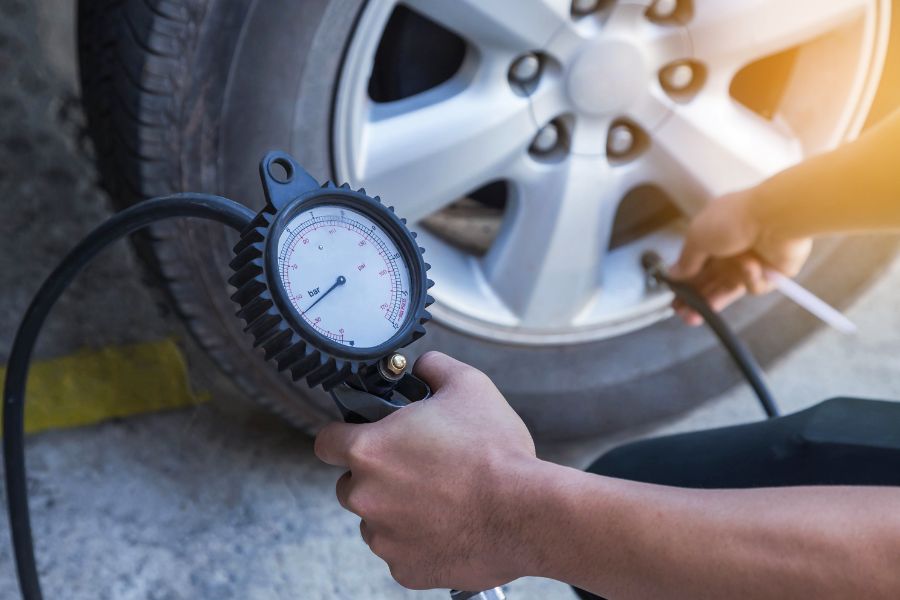
What Is TPMS & How Does Tire Pressure Work?
Imagine driving on a serene road with the wind brushing against your car. Your favorite tunes are playing, and suddenly, you feel an odd drag or tug—alert pings on your dashboard. The tire pressure monitoring system (TPMS) light is on! But how does tire pressure work, and why must your car have a dedicated system to monitor it?
Since vehicles have been rolling on rubber, tire pressure has been pivotal to having a smooth and safe journey. In the early days of automotive invention, the significance of tire pressure wasn’t as emphasized. However, as cars evolved, so did our understanding of the critical balance between air pressure inside the tire and the open road.
Now, let’s start from the basics:
What is Tire Pressure?
At its core, tire pressure is a measure of the air in a tire, usually denoted in units such as psi (pounds per square inch), bar, or kPa (kiloPascal).
Think of your tire as a sealed balloon. When you pump more air into it, the air pressure increases. Likewise, the pressure decreases if there’s a leak or the air inside cools down.
Maintaining proper tire pressure is more than just ensuring a comfortable ride; it’s about optimizing safety, performance, and fuel efficiency. And that’s where tire pressure monitoring systems (TPMS) come in. These nifty systems constantly work behind the scenes to provide tires with the proper air support for every twist, turn, and long stretch.
There are two main types of TPMS: direct and indirect. Direct TPMS measures the pressure in each tire directly and sends this information to the car’s computer system. On the other hand, indirect TPMS doesn’t measure air pressure. Instead, it uses wheel speed sensors to monitor the rotational speeds of each tire. If one tire rotates at a different rate than the others, it could be under-inflated, and the system triggers an alert.
Both these systems play a crucial role in helping drivers understand and maintain their tire health, especially in today’s fast-paced world where every second counts. Speaking of a fast-paced world, we can help you keep up with the connection between forest science and AI or microscopy.
How Tires Hold Air
Every road journey you embark on is, in essence, a dance. A harmonious ballet between the ground and the four rubber circles keeps your vehicle afloat. But what ensures this dance is graceful rather than clumsy? The secret lies in how tires hold air.
Much like a balloon deflates easily without its rubbery confines, a tire, without its specially designed inner liner, would be a poor vessel for air. This liner acts as a barrier, maintaining the air pressure inside. Modern tires, especially those with built-in tyre pressure monitoring system sensors, elevate this simple concept to an art form. These sensors continuously gauge the air within.
But tires have evolved. Gone are the simple tubed tire days, where an inner tube held the air. Thanks to rubber technology and design innovations, today’s tubeless tires have air without needing a separate inner tube. Hence, they are more resistant to sudden deflations.
Why Is Tire Pressure So Important?
Picture this: A sunny day, open roads, and suddenly, the dreaded TPMS warning light blinks on your dashboard. This isn’t just a fancy light show; it’s a vital cue that something might be off with your tires. But why should a little less or more air make such a difference?
Safety First
One of the primary concerns with improper tire pressure is safety. An under-inflated tire doesn’t distribute weight evenly, increasing the chances of a blowout. On the flip side, an over-inflated tire reduces the contact patch with the road, leading to less traction.
Economical Driving
Proper tire maintenance isn’t just about safety; it’s also about your wallet. A tire at optimal pressure reduces the rolling resistance, improving fuel efficiency. Plus, evenly worn tires last longer, so you won’t be rushing to the tire shop soon.
Keeping Up with Technology
With the rise of aftermarket systems designed to keep drivers informed about their vehicle’s health, tire pressure monitoring systems stand out.
Direct TPMS sensors, in particular, are exact. These pressure sensors in each tire directly measure the air pressure and promptly alert the driver through the warning light if something’s amiss.
Performance on the Go
Have you ever noticed how your car handles better on some days than others? The secret might just be in your tires. Properly inflated tires respond better to steering inputs and boost smoother ride.
Factors Influencing Tire Pressure
Ambient Temperature
Tires, like humans, are sensitive to temperature. So, a drop in the thermometer can mean a reduction in tire pressure. This happens because air contracts when it’s cold, reducing the volume and, thus, the pressure inside the tire. Conversely, a hot summer day can expand the air, increasing the pressure. It’s the science of gases at play right beneath your feet!
Vehicle Load
Packing for a long trip? Do you have a car full of friends or luggage? The added weight impacts the tire pressure. A loaded vehicle exerts more force on the tires, often leading to an increase in tire pressure.
Tire Wear and Damage
Wear and tear aren’t just phrases; they’re real-life phenomena affecting your tires. Reduced tread influences how pressure gets distributed across the tire. Moreover, any damage or puncture, even if it doesn’t result in an immediate flat tire, causes a slow leak, gradually reducing tire pressure.
Altitude
As we climb higher into the mountains, atmospheric pressure drops. And this may directly affect your tire pressure. While the change might not always be drastic, it’s another factor the intricate sensors, especially the direct sensors of a tire pressure monitoring system, pick up on.
How to Check and Maintain Correct Tire Pressure

In the sophisticated age of technology, with direct and indirect TPMS systems alerting us, one might wonder, “Do I still need to check my tire pressure manually?” The answer is a resounding yes! Agreed; the indicator light from your TPMS system is a tremendous first alert. But there’s nothing quite like hands-on tire maintenance for optimum performance.
Regular Checks
Your TPMS light isn’t a constant monitor; it alerts you when there’s a significant deviation. Hence, routinely check your tires with a reliable gauge to stay ahead of any potential issues.
Understanding Direct and Indirect Systems
It’s essential to understand the type of TPMS your vehicle uses. Direct TPMS sensor systems measure air pressure directly inside the tire. Indirect systems, on the other hand, rely on wheel speed sensors and interpret a potential pressure loss through discrepancies in tire rotation. While direct sensors give a more accurate reading, understanding both helps you pinpoint issues faster.
Tire Rotation and Maintenance
Every tire wears differently, especially at different positions on a vehicle. Regular tire rotation promotes even wear, prolonging the life of your tires and aiding consistent performance. This, combined with routine checks for punctures, tread act, and sidewall damage, forms the backbone of proper tire maintenance.
Maximizing Fuel Economy
Correct tire pressures aren’t just about safety; they’re directly tied to fuel economy. An under-inflated tire increases rolling resistance, making your engine work harder and guzzle more fuel. Regular checks and prompt attention to the TPMS sensor warnings save you a good deal at the pump.
Misconceptions and Myths Surrounding Tire Pressure
Dive into any topic deeply enough, and you’ll inevitably encounter myths and misconceptions. Tire pressure, despite its scientific roots, is no exception. Some myths have been around for about a decade, while others are as old as the automobile. Let’s debunk a few!
“A Little Less Air is Okay”
One of the most common misconceptions is that under-inflated tires offer a smoother ride. Frankly, a lower inflation pressure might seem to provide a softer ride initially. However, it comes at the cost of uneven wear, reduced fuel efficiency, and a significant safety risk due to the potential of a blowout.
“All Tires Deflate Equally”
Just because one tire shows perfect pressure doesn’t mean they all do. Different wheel speeds, wear patterns, and slight damages lead to varying tire pressure readings. Regular tire rotations and checks can keep these discrepancies in balance.
“I Can Tell a Tire’s Pressure Just by Looking”
When a tire looks visibly under-inflated, its pressure is dangerously low. Trust in technology: A TPMS system or a good old pressure gauge will give you a far more accurate reading than a casual glance.
In Essence
Luckily, “how does tire pressure work?” isn’t one of the unanswered questions in chemistry and science. Tire pressure is the unsung hero of every vehicle’s journey, harmonizing safety, efficiency, and performance. With evolving technology like TPMS, understanding tire pressure isn’t just mechanics—it’s a dance between vehicle and road. Remember, every smooth turn and safe stop owes its grace to the air cushioning your tires.

